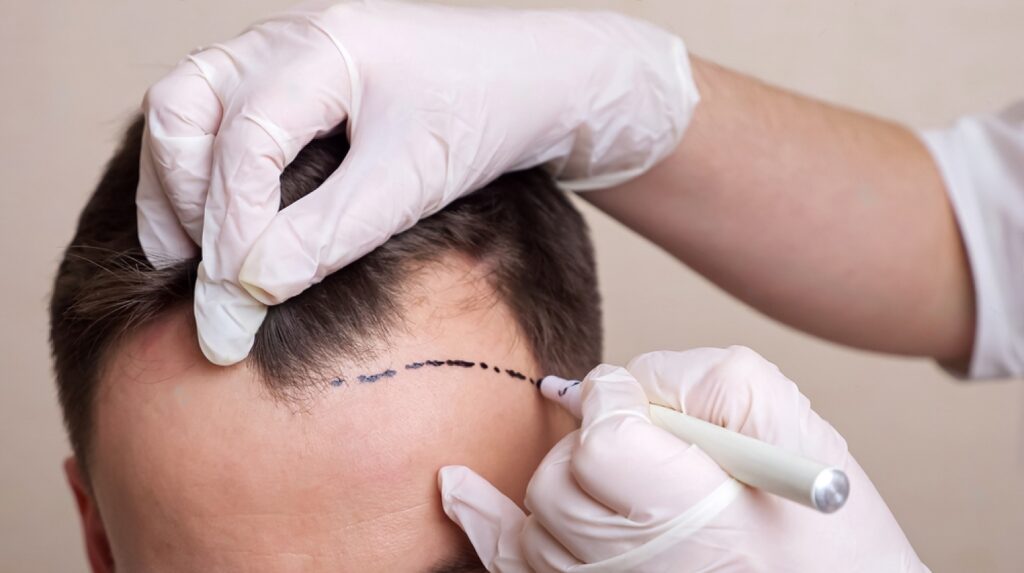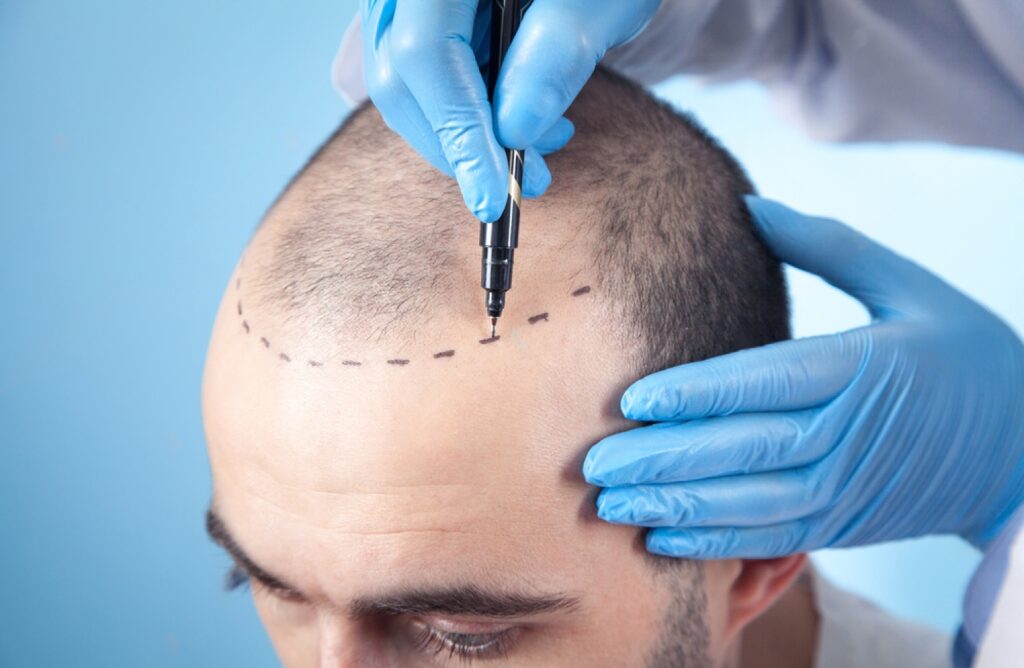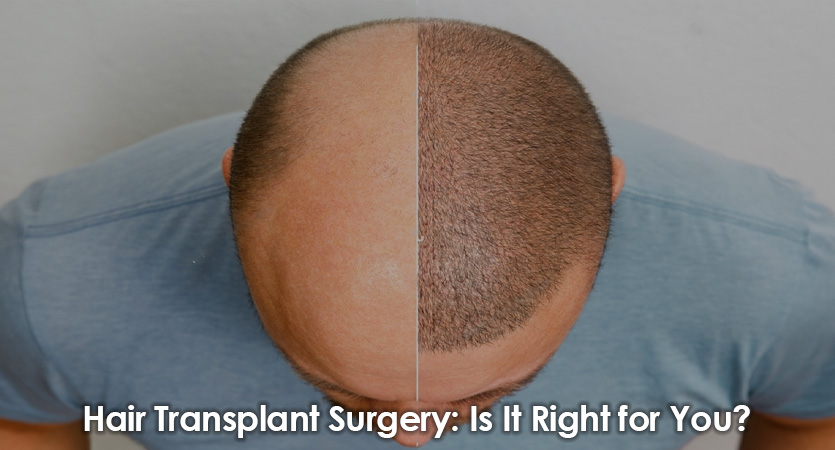If you want to stop losing your hair, consider getting a hair transplant. Hair transplant surgery involves the surgical relocation of scalp hair from areas of fullness to those of thinning hair. Modern techniques have made it possible to get very realistic results with minimal scarring. Most surgeons now only move a small number of healthy hairs at a time. Back then, pieces of hair called “hair plugs” were put in the area where hair was getting thin. Over time, the hair plugs stood out a lot. Improvements in how the hairline is made and the hairs are placed in the thinning areas also help the results look more natural.
Outcomes Rely Primarily On The Surgeon
Hair transplant surgery in Lahore, Pakistan, at AZ Plastic Surgery Associates is performed on patients with baldness caused by various factors, including heredity, hormone imbalance (androgenic alopecia), flaming alopecia, and traumatic hair loss.
Dr. Zain is a well-known hair transplant surgeon with a lot of experience. Your hair transplant doctor must be a licensed FCPS plastic surgeon with a PMDC number. Our dermatologists are experts in skin, hair, and nail problems, so they know much about hair loss. Many of them can also conduct hair transplants and advise you on whether or not you would be a good candidate.
How Effective Are Hair Transplants?

A hair transplant is usually more effective than over-the-counter hair restoration products.
- After three to four months, anywhere from 10–80% of the transplanted hair will have fully grown back.
- Transplanted hair, like natural hair, will get thin over time.
Hair transplants only work for a select few. Those who are balding or thinning out naturally or have lost hair due to an injury commonly use them to regrow their hair. The hair used in most transplants is the patient’s own. Hence they are not as effective in treating:
- Loss of hair and widespread balding
- Chemotherapy and other drug-induced hair losses
- Deep wound scars on the crown of the skull
Explain The Process Of A Hair Transplant

Hair transplants are performed to fill up bald spots; on the head. Although the back of the head is a common extraction site, additional locations are possible.
The donor site is numbed and sterilized before a hair transplant is performed. You can request anesthesia if you would rather not be awake during the surgery.
Subsequently, your surgeon will perform a Follicular Unit Transplant or Follicular Unit Extraction.
Transplantation of follicular Units (FUT)
A different name for FUT is follicular unit strip surgery (FUSS). To do a FUT operation, your doctor will:
- Remove and dispose of some scalp from the back of your head. The strip is typically between 6 and 10 inches long, although it can extend from one ear to another if desired.
- If your hair is shaved off, you’ll need stitches to close the wound.
- Your doctor and his assistants will use a knife to make the scalp strip more manageable. They might divide the work into as many as two thousand grafts. There may be as little as single hairs in some of these grafts.
- The surgeon will use a needle or blade to make small incisions in your scalp.
- The holes are filled with hairs taken from the removed section of the scalp. This process is referred to as grafting.
- Bandages or gauze were then applied to the surgical incisions.
The following factors determine how many grafts you receive:
- How long is your hair?
- How big is the area for the transplant?
- Hair’s qualities, particularly its thickness,
- Hair color
Removing Follicular Units Extraction (FUE)
The following steps your doctor will take during an FUE procedure:
- You get a buzz cut if you have any hair on the back of your head.
- Next, the doctor manually extracts each hair follicle from the patient’s scalp. Each strand’s removal will leave a little mark.
- Like the FUT procedure, your surgeon will create small incisions in your scalp and implant new hair follicles there.
- The surgical incision was then covered with gauze or a bandage.
Recovery After Hair Transplant:
The process of hair transplant takes between 6 and 7 hours. You can eat, watch movies, and talk on the phone during the procedure. A hair transplant can be done in one day. On the same day, you can walk home. You might have pain in your scalp after the surgery, so you might need to take painkillers and antibiotics for a few days. Most people can go back to work in two to five days.
Is A Hair Transplant Successful For Anyone?

Transplanting hair successfully works for both sexes and all races.
You’ll need two things to get a hair transplant:
- Your scalp hair is in good condition to be transplanted to the thinning areas.
- During your dermatologist visit, you might inquire whether you suffer from either issue—in-depth scalp examination by a dermatologist.
If you want to know why you’re losing your hair, a blood test may be necessary. That can help determine whether or not hair loss is due to an underlying medical condition. Your dermatologist can easily and quickly perform the scalp biopsy during your consultation.
After an examination and diagnostic tests, your dermatologist can tell you if you are a good candidate for a hair transplant. Even if you can’t get a full head of hair, at least you can aim to have more.
When Is It Too Late For A Hair Transplant?
Waiting until age 30 is recommended, while exceptions are always due to individual patient circumstances. The most important thing to remember for those considering surgery is that their hair loss should have halted by that point.
Hair transplants are an option for patients who have experienced hair loss or thinning. That might be a long-term change. If a person continues to lose their hair, they will eventually have bald spots in addition to the ones where they’ve received hair transplants.
FAQ’s
Is a hair transplant right for you?
Not everyone can get a hair transplant to work. Most of the time, they are used to grow hair back on people who are balding or thinning out naturally or who have lost hair because of an accident. Most transplants use your hair, so they don’t work as well for people with broad thinning or baldness.
Is getting a hair replacement dangerous?
A hair transplant is safe surgery, but there can be side effects like pain, itching, and unhappiness with the results. There can also be problems during the surgery, like an infection, a wound that doesn’t heal properly, or dead skin.
When is the best time to get a hair transplant?
As a rule of thumb, people over 30 should think about getting hair transplant surgery. Before getting surgery, people younger than 30 should try hair loss medicines to stop their hair loss.
Does hair that has been transferred look real?
Over time, the hair plugs stood out a lot. Improvements in how the hairline is made and the hairs are placed in the thinning areas also help the results look more realistic. Because of these improvements, the results can look so natural that a barber or stylist might be unable to tell you’ve had something done.
What does it cost to get a hair transplant in Pakistan?
The price of a hair transplant in Pakistan can range from 50,000 to 400,000 rupees, based on where you get it done, how many hairs are transplanted, which doctor does the surgery, and which method is used.


